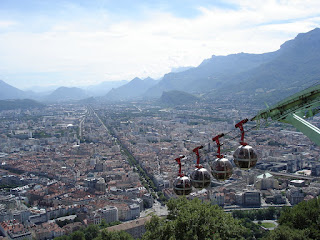View July 23rd - August 3rd 2010 in a larger map
After a week in the lap of luxury in a proper house, we headed on to somewhere that Alex’s dad had recommended - the Gorges du Verdon. This area of Provence is full of colour at this time of year, with fields of lavender and sunflowers dotting the countryside and making for a stunning drive.


The Gorges du Verdon is sometimes referred to as Europe’s Grand Canyon, and the area is simply breathtaking. The river Verdon has cut a huge tear in the limestone hills which runs for 25km and is some 700m deep in places. You can drive all the way around the rim on some of the best roads we’ve seen. They’re spectacular and a little hairy in places especially if, like Alex, you suffer from vertigo!


At the end of the gorge the river flows into the Lac de Sainte-Croix, another beautiful sight with its striking turquoise-green water. It’s a popular spot, and for good reason. The warm water in the lake is great for swimming and messing about in boats. We loved it and spent a few days in the area. After driving around the gorge and taking a huge number of photos, we hired a canoe on the lake and paddled part of the way up the gorge (along with hoards of other holidaymakers in brightly coloured pedelos, canoes, and motorboats).

From here we started our journey north, heading for a rendez-vous with David’s parents in Germany. Our route skirted the French Alps and some magnificent mountain scenery. We passed through the area last summer and agreed that we had to go back to explore it properly.
The city of Grenoble is situated at the confluence of 2 rivers (the Drac and Isere) and a fortress looks out across the city from the hill above. We’d heard that you could wild camp just next to the fortress so we headed up the very steep and narrow access road. There was a bit of a panic when we thought the van wouldn’t make it up the hill, but we arrived safely and were able to get the cable car down into the city centre.

Grenoble was at the centre of the resistance movement during the Second World War, and today it houses the Museum of Resistance and Deportation. The museum tells the story of the small resistance groups in the region, and the bravery of those who risked their lives to fight the Nazis. It was only towards the end of the war that they began to receive air drops from the allied forces to help them in their missions.
While in Grenoble we made a concerted effort to expand our rather limited menu! We don’t have an oven or a microwave in the van, and we’re on a tight budget so eating out is a rare treat. So far we’ve managed quite well on a menu of light, summery, Mediterranean dishes like leak and potato soup, bangers and mash, and shepherd’s pie! So, having put the word out for new easy recipes, we tried out Simon’s Paella and Mum’s Liver and Bacon. And we still can’t work out why we’re putting on weight!

We headed north from Grenoble and past Lac de Bourget, the largest freshwater lake in France near the spa town of Aix les Bains. From here it was on to a place we visited last summer and fell in love with - the little town of Annecy and the lake with the same name.
Surrounded by mountains, the lake and town are typical picture-postcard alpine scenes, and even the large number of tourists can’t spoil the wonderful atmosphere. We drove around the lake on a hot Saturday and it seemed that anywhere big enough to lie down was good enough for a quick sunbathe, even the pavement!
The town centre is a maze of alleyways, canals and historic buildings, it’s a great place to wander or to sit and watch the world go by. We found a spot to camp next to the lake with a view across to the town. Unfortunately the road we parked next to turned out to be a little busier than we thought, and it was only at 3am we realised we were quite close to the local nightclub as well!

We seemed to leave the good weather behind us as we passed from France into Switzerland. Driving along little country roads, we didn’t even realise we were in Switzerland at first!
We headed straight to Lake Geneva and found a good place to park for the night just outside the city on the banks of the lake. It was Swiss national day so a huge fair was set up in Geneva and we had a great view of the fireworks displays taking place around the lake that evening. The only problem was the weather - it rained constantly! After a very soggy walk into the city the following day, we decided to cut our losses and move on.

If you ever drive to Switzerland it’s worth knowing about the vignette. Rather than road tolls, to drive on the main roads and motorways you have to purchase a sticker and place it in your windscreen. The only issue is that there’s only one year-long pass available costing 30 euros. So if you’re passing through and only in the country for 2 days (as we were) it’s a bit of a bugger!
From Switzerland, it was on to Germany and the lovely city of Laufenburg. A small town in reality, Laufenburg faces a similar city of the same name across the river Rhine in Switzerland. Laufenburg was in fact one city until Napolean divided it and made the Rhine the border in the 1800s. The two cities are connected by a bridge so it does feel like one town, but the national flags remind you exactly which country you’re in.
Next time –Ellis week!





